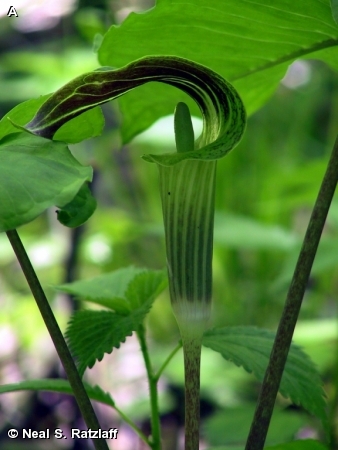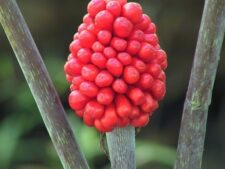
This native perennial emerges as a green and brown spike and becomes a flowering stalk up to 2 feet tall (A,B). The club-like “jack,” first green then purplish brown, sits in a sheath with hood (like a pulpit). The two leaves, on stout stalks, have 3 large leaflets each (B,F). The fruit clusters are first green (C), then a shiny red by late August (D). And when the flower is just about ready to wilt – on darker stalks now – and the light is just right, then you might experience what looks like a “flame” (E). By mid-summer the stalks holding the large leaves often fold over just below the three leaflets to reveal the much lighter undersides (F).
Grows in moist, shady woodlands, flowering in April and May. In Fontenelle Forest and Neale Woods it is common in moist ravines and lowlands. It is less common in moister shaded areas in upland woods.
Dinsmore indicates the Pawnee pulverized the fleshy underground stems.and applied them as a counterirritant for rheumatism and other pains. The seeds were placed inside gourd shells and used as rattles.
Jack-in-the-Pulpit plants are a bit unusual in that they are capable of changing gender. An individual plant, thus, may be female, male or possess both male and female parts and gender may change from year to year. Generally, smaller plants tend to be male and larger, more mature plants female.
Other common names include Preacher-In-The-Pulpit and Indian Turnip.
The content of NatureSearch is provided by dedicated volunteer Naturalists of Fontenelle Forest who strive to provide the most accurate information available. Contributors of the images retain their copyrights. The point of contact for this page is: Roland Barth.

 Identification
Identification



